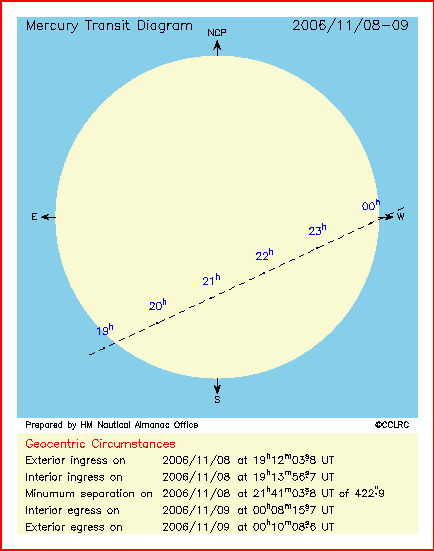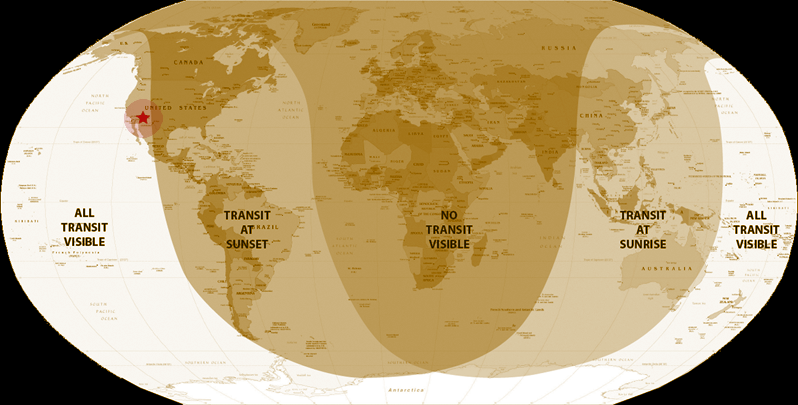In case you do not already know, Mercury transit is a real physical astronomical event, and not some bus or subway train in some city of some country in this world. If you remember the early days of your life when you were in grade school, you will recall that we live in the so-called Solar system, and we are "the third rock" from the sun. There are two more rocks, Mercury and Venus that orbit closer to the sun than our earth. For this reason, once in a while, sometime a long while, from earth, either Venus or Mercury can be seen streaking across the surface of the sun. That is called a transit. Last week, on November 8, the planet Mercury did just that.
Thanks to human's ability to perform complex mathematical calculations, we know when these events occur and where to look so we are always prepared to witness them in action.
Mercury transit is a BIG deal. Every astronomer in the world has prepared for this event for months and they were all ready last week. The last transit was on May 7, 2003 and the next one will not occur until May 2016. This year, the year 2006, a live webcast from Kitt Peak National Observatory's exploratorium was set up to let the world participate in this event. Of course, I took some time off my busy schedule of doing mostly nothing to watch this rare event. The webcast used a Mead 16" telescope with special solar filter as a main tool but it had two other telescopes with different viewing equipment.
Watching the sun is never an easy task. I remember as a kid, I was taught to watch solar eclipses by looking at a dimmed reflection from a bucket of water, or through a piece of exposed film. Nowadays, the world has grown much more sophisticated and we have more gadgets to fit our fancies to do these things. I do have a telescope, but not about to deploy it for this event because without special solar filtering equipment, I do not think my retinas will survive the ordeal. So the webcast was such a nice gift. Thank you, Kitt Peak observatory! Knowing this being a LONG event, I was prepared for a planned 5 hour+ session. Here is the story book:

As way of background, the time is UT ("Universal time") or GMT ("Greenwich Mean Time") which is five hours ahead of Eastern Standard Time (EST) for people who live in the Eastern seaboard of the US like myself. As seen here,

not everyone on earth could see the transit the same way. Most of the area surrounding the continent of Africa could not see it at all. Australia and Western Pacific saw the transit at sunrise while most of North and South America could view a portion of the transit during sunset. Kitt Peak was ideally positioned to see this Mercury transit in all its entirety.
The webcast was ably commented by expert astronomers who took turns explaining what was being shown. Even these seasoned professionals got all excited when the planet Mercury started its trajectory across the surface of the sun, called first, second third and fourth contacts. Three telescopes were fitted to display views of the sun in white light with orange filter, in hydrogen alpha visible light and in excited calcium wave length. Needless to say, all images seen during the webcast were excellent, one of which appeared like this:

Truthfully, after about an hour, the webcast looked pretty boring because all you see was a round dot inside an orange square. Every now and then, the experts would come back on line to engage the viewers. At one time, they gave a tour of the edge of the sun, which was great because I do not think you can get that kind of tour from any travel agency on earth. I went for the distance and stayed with the webcast until the bitter end when it signed off, after Mercury finished its final fourth contact, egressing the surface of the sun and bid it goodbye until the year 2016.
OK. So, how was it, you ask? Was it time well spent or a total waste of 5 hours plus? What's the point in all this? If you revisit one of my previous blogs, on September 17 of this year, you can watch a pool table trick shot. If you understand French, you may hear a comment by a woman spectator: "... the exhibition serves no purpose and it is an unbelievable waste of time," to which there are some potent male chauvinistic replies from the French men that will not be repeated here. So, the answer is "beauty is in the eye of the beholder," which on its own merit can be subject of another blog. I may do that in the future, who knows?
Scientifically speaking, many experiments were being conducted during the transit because it offered unique opportunites to use the sun as a backgroud that aids in the study, for example, of Mercury's sodium content in its atmosphere that is not possible otherwise. You didn't know that Mercury has an atmosphere, did you? See? Time NOT wasted!
Me? I have a totally different take. I felt so sorry for our poor planet Mercury watching its transit. Undoubtedly, many times in one's lifetime, one cannot help but to feel lonesome to some degree. Such potentially devastating condition of the human mind can be detected in many well known literary authors as reflected in their books, theatrical plays, movies and other art forms. One famous such work was a song written in 1949 by Hank Williams, bearing the same name as the title of this blog. If you listen to the rendition of that song by country singer Johnny Cash, you probably would want to die. If you think that human loneliness is bad, think about the poor planets in our poor solar system that includes our own poor earth. We are all but a collective mass of matter destined to wander eternally without hope of escape in the boundless, empty, cold and dark void of the universe until death dawns. The fact that we are a thinking species makes it much worse. Can we be better off being just rocks? Are we sure rocks do not feel pain?
So, please take a look at a composite of the now history Mercury transit that lasted 5 hours +:
.
That is a LONELY trek that repeats for an eternity. How sad! Now that you can see it, perhaps you can feel it!



No comments:
Post a Comment